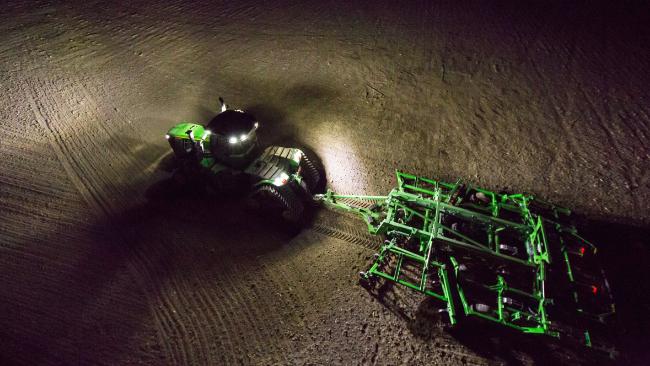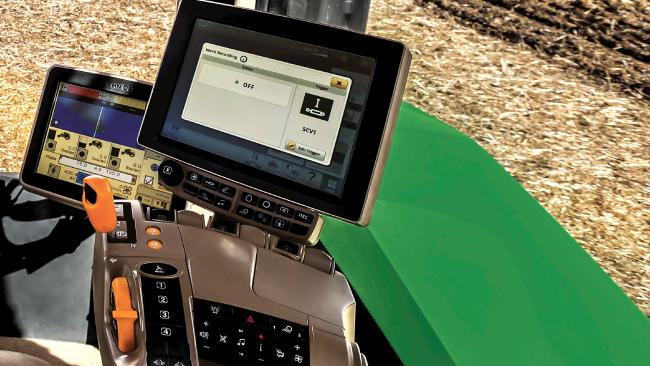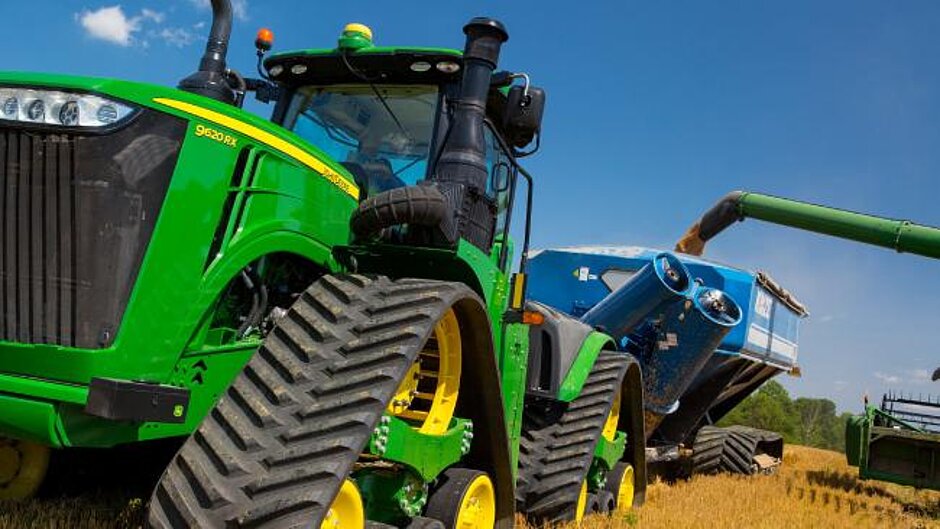AT THE top of tractors there are the 600hp-plus articulated crop monsters rolling on four tracks, and earlier this year John Deere brought its 9RX here to compete in that space.
It’s a category dominated by Case IH’s Steiger Quadtrac and Rowtrac which have refined the technology for 20 years, but John Deere says it’s taking it a step further.
“Innovation not imitation” is its marketing slogan to counter Case IH’s “Beware of imitations” campaign as the pair duke it out. Versatile’s DeltaTrack is there, too, happy to sit back without getting involved in the red versus green stoush.
The official Australian launch for the 9RX was recently held in the Wimmera, right in the heart of Victoria’s broadacre cropping district where it is most at home.
John Deere sent large-tractor marketing manager Jerry Griffith from the US to explain what the brand wanted to achieve getting into this niche market.
“So why would a customer want a four-track tractor?” he asks rhetorically.
“It’s got one of the largest footprints and provides excellent flotation. It works well in dry sandy soils and if you have to deal with mud the flotation ability to get in to do your work sooner and stay longer in the season.
“It’s got an excellent ability to turn on the move. Because of its articulated design, if you’re doing seeding or tillage and have to work around trees or drainage, this has the ability to maintain power under load.”
The tall undercarriage, with its 1003mm diameter drive sprocket, was built by specialist Camso (formerly Camoplast) using John Deere design and components.
It has a 72-inch (1800mm) footprint between idler centres with belt tensioners applying 16,000lb of pressure on a 3500 Series or optional heavy duty 6500 Series rubber track. These come in 30 and 36-inch widths. It’s the tall undercarriage and two larger mid-rollers as opposed to three small rollers that John Deere says are its points of difference with Case IH and Versatile.
“We made it taller because the 620hp model has a peak horsepower of 670 horsepower with a 10 per cent boost, so we built it to handle that power,” Jerry says.
“Because it’s taller, the belt is longer and that helps to dissipate heat better. Likewise on the amount of wrap on the top sprocket, we have a little over seven lugs of engagement and our lugs are wider.”
With the drive sprocket position requiring the front axle to be higher than the wheeled variants, John Deere had to make a heavy-duty chassis modification to suit.
“The way we get the power transfer to the top sprocket is through an upswept axle,” Mr Griffith says. “We pour that in our own foundry and it’s the largest cast pouring of any manufacturer in North America.”
The other main point of difference in the undercarriage is that it has two larger mid rollers rather than three.
Jerry says this helps with heat dissipation and reduces shock.
“The main reason was to go with big components,” he says. “Larger diameter means less turns so there’s more heat dissipation, and with the belt tension, we have a nice flat plane between the idlers.
“Also if you have a third roller in there, it’s right underneath the axle and if you hit an obstacle it will send the shock straight up through those components and into the cab suspension system.”
That cab suspension is also something John Deere likes to highlight.
“We have a four-post, four-corner suspension system, which is different to our other row crop tractor cab suspension which has a hinge at the front and suspension at the rear of the cab,” Mr Griffith says.
“Then we have parallel links either side of the cab to keep movement vertical so it doesn’t yaw, pitch or roll.
“There’s a torsion bar that runs across the front that helps to eliminate side-to-side pitch, and a cross bar at the rear of the suspension system.”
There’s nothing new in the three engines that are used in its wheeled articulated 9 series – the 13.5-litre PowerTech 6-cylinder turbo diesel in either US Tier II or Tier IV or the 14.9-litre Cummins QSX15 6-cylinder turbo-diesel that only comes in Tier IV.
These are shared with the wheeled 9-series tractors and are available in 470, 520, 570 and 620 horsepower and are coupled to e18 18-speed powershift transmissions capable of a top transport speed of 40km/h.
John Deere didn’t see the need to alter its hydraulic configuration for the 9RX either, offering a maximum of 435 litres of hydraulic flow per minute.
Tracked tractors offer many benefits, although Jerry concedes that there are limitations.
“It won’t have as much drawbar pull as a dual-wheeled version of the same tractor because you lose power just driving the four-track system,” he says.
There’s also the additional cost. The 9620RX is $680,296. The 9620R wheeled version was recently listed at $542,995.
“The up-front cost is more because it has more moving parts,” Mr Griffiths says.
He also says there’s no option at this stage for different spacings for those looking at controlled traffic farming.
“We’re not ready to introduce it on this tractor yet, but it’s something we’ve got on our radar. We are working on a narrow-track tractor in either an 18 or 24-inch.”
JOHN DEERE 9620RX
- Engine cummins qsx15 turbo diesel
- Cylinders/cc 6/14,900
- Rated engine power 620hp/456kw
- @ rated speed 2100rpm
- Boosted power 670hp/492kw
- Torque rise 36%@1600rpm
- PTO speeds 1000
- Transmission 18-speed powershift
- Max speed 40km/h
- Hydraulics closed centre pressure/flow compensated
- Max hydraulic flow 435litres/min
- Three-point linkage cat iv, quick hook
- Max lift at lift end 9000kg
- Drawbar cat iv/5440kg max vert load
- Turning radius 6400mm
- Weight 26.761kg
- Price $680,296
Source: weeklytimesnow.com.au



